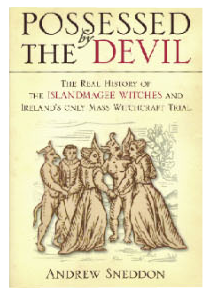Possessed by the devil: the real history of the Islandmagee witches and Ireland’s only mass witchcraft trial
Published in Issue 1 (January/February 2014), Reviews, Volume 22Andrew Sneddon
(The History Press Ireland, €16.99)
ISBN 9781845887452
 In late 1710 Ann Haltridge of Islandmagee began to be haunted in a variety of ways, most notably by a demonic ‘boy’ that threatened her with frightening regularity. She died in February 1711 after a catalogue of sinister incidents, and in the aftermath of her death her niece, Mary Dunbar, came to stay with the family. Yet Mary Dunbar soon reported that she too was being tormented by witches in the locality: cue the reappearance of the demonic boy; the appearance of another apparition known as ‘Mistress Ann’; fits and convulsions; the vomiting of pins and feathers by the afflicted; levitating household items; sinister charms left lying around to bewitch the unfortunate Mary Dunbar; and finally, as the subtitle implies, ‘Ireland’s only mass witchcraft trial’.
In late 1710 Ann Haltridge of Islandmagee began to be haunted in a variety of ways, most notably by a demonic ‘boy’ that threatened her with frightening regularity. She died in February 1711 after a catalogue of sinister incidents, and in the aftermath of her death her niece, Mary Dunbar, came to stay with the family. Yet Mary Dunbar soon reported that she too was being tormented by witches in the locality: cue the reappearance of the demonic boy; the appearance of another apparition known as ‘Mistress Ann’; fits and convulsions; the vomiting of pins and feathers by the afflicted; levitating household items; sinister charms left lying around to bewitch the unfortunate Mary Dunbar; and finally, as the subtitle implies, ‘Ireland’s only mass witchcraft trial’.
The Islandmagee case is unique in the admittedly slender annals of Irish witchcraft. The same names and incidents tend to recur in any discussion of the topic: the prosecution of Alice Kyteler in Kilkenny in 1324 (with the subsequent execution of her unfortunate servant Petronella de Midia) and the execution of Florence Newton of Kinsale in 1661. To these can be added the strangling of a suspected witch in Antrim in 1698, and the Islandmagee case that Andrew Sneddon has meticulously investigated in this short but fascinating book. What made it so distinctive is that, unlike the cases above, the Islandmagee case involved the prosecution and conviction of eight women for the crime of ‘bewitching’ Mary Dunbar. There is an obvious echo of the famous trials in Salem two decades earlier, but Sneddon does not force unnecessary parallels in an attempt to make his account more eye-catching than it already is. His book is an impressive example of accessible scholarship, and Sneddon brings a wide knowledge of the contexts of British and European witch beliefs to bear on the tale he tells in this lively and engaging study.
The existence of witches and witchcraft—or the existence of beliefs in such things—is usually overlooked in the history of early modern Ireland. This omission may well be due to the dominance of larger narratives of colonisation and conquest, but these narratives form an essential backdrop to the story told here. There were compelling demographic and social factors that shaped the context in which the Islandmagee case took place. Mary Dunbar’s accusations were made in a Presbyterian community deeply influenced by Scottish beliefs in witches that tended, to a greater degree than parallel beliefs in England, to view witchcraft as direct action on the part of Satan. Beliefs in witchcraft were perhaps inevitable in a culture to which Scripture and the existence of the devil were fundamental. But irrespective of differing emphases on the nature of witchcraft, cases of this kind were being noted in minority colonial communities. There were bound to be fewer cases of witchcraft in Ireland than in Britain or on the Continent. In Catholic, Gaelic Ireland, more pervasive and wide-ranging beliefs in the supernatural may well have tempered any necessity for a belief in specifically malevolent individuals; in any case, allegations of sorcery amongst the Irish were unlikely to have registered with the Anglophone authorities.
Sneddon’s book is reminiscent of Angela Bourke’s The burning of Bridget Cleary, another impressive micro-history in which an incident that spoke to the existence of the ‘irrational’ was used to illuminate large swathes of the society in which its central event took place. Possessed by the devil is erudite, accessible and very readable. Sneddon meticulously embeds his story in its wider Irish, British and European contexts as it unfolds, and brings a great deal of scholarship to bear on his tale. But the narrative is never far away: there are no lengthy digressions that go on for pages, ending with phrases such as ‘meanwhile, back in Islandmagee’.
The problem is that, unlike Bourke’s book, there is no obvious denouement. On 31 March 1711 eight women were found guilty of bewitching Mary Dunbar under the relevant law of 1586, but the precise nature of the sentences and the punishments were not recorded (though a twelve-month sentence and a spell in the pillory, as stipulated by the law, seem likely outcomes). Having come up with a convincing (earthly) explanation for the accusations, it is a pity that Sneddon cannot follow them to their ultimate conclusion. Such are the limits of the sources, but the journey around an obscure netherworld of supernatural beliefs on which he leads the reader is one worth taking. Sneddon has a sharp eye for telling details, and Possessed by the devil clips along at a good pace. It is published in a handsome and affordable edition by the History Press Ireland, and is usefully furnished with a decent chronology and list of dramatis personae, along with an extremely thorough bibliographical essay. As both a very good read and a genuinely fascinating (and overdue) excursion into Irish cultural history, it can be highly recommended. HI
John Gibney is on-line editor of History Ireland.
















